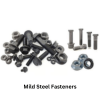After Travelling the world, have you ever considered how aircraft maintenance is done or what challenges it takes? A small detail is important for them and can’t be ignored; it’s all related to our safety.
In the bustling world of aviation, where cutting-edge technology and precision engineering take centre stage, it’s easy to overlook the humble components that hold it all together. Among these unsung heroes are mild steel fasteners, small but vital pieces that play a crucial role in ensuring the safety and functionality of aircraft. In this blog story, we dive into aircraft maintenance and shed light on the significance of mild steel fasteners.
The Backbone of Aviation Maintenance
When maintaining and repairing aircraft, attention to detail is paramount. Every part of an aircraft, from its massive engines to the tiniest screws, must be inspected, maintained, and replaced as needed. This meticulous process ensures the aircraft remains in peak condition, ready to soar through the skies.
Despite their unassuming appearance, mild steel fasteners are integral to this process. These fasteners are used to secure various components of an aircraft, ranging from structural elements to interior fixtures. They come in various shapes and sizes, including bolts, screws, nuts, and rivets. Their primary function is to provide a strong and secure connection between aircraft parts.
Challenges in Aircraft Maintenance
Maintaining an aircraft is no small feat. Modern aircraft comprise thousands of individual parts, each subject to extreme stresses, temperature variations, and environmental factors. These conditions can cause wear and tear, leading to the need for frequent inspections and replacements.
One of the key challenges in aircraft maintenance is ensuring that every component, including mild steel fasteners, remains in optimal condition. The consequences of failing to do so can be catastrophic, jeopardizing the safety of passengers and crew. Therefore, rigorous maintenance procedures and high-quality materials are essential to prevent accidents.
The Role of Mild Steel Fasteners
Mild steel fasteners, chosen for their durability and strength, are used in various critical areas of an aircraft, such as:
- Structural Connections: These fasteners assemble the aircraft’s structure, including its wings, fuselage, and landing gear. Their ability to withstand high tensile and shear loads is essential for maintaining structural integrity.
- Engine Components: Mild steel fasteners secure the various components of an aircraft’s engines, ensuring they remain in place during operation. This is crucial for both safety and performance.
- Interior Fixtures: Besides structural applications, mild steel fasteners secure interior fixtures like seats, overhead bins, and cabin panels. Passengers’ safety and comfort rely on the proper installation of these fixtures.
Challenges and Innovations
Despite their importance, mild steel fasteners face challenges such as corrosion, fatigue, and wear over time. To address these issues, advancements in materials science and engineering have led to the development of corrosion-resistant coatings and high-strength alloys, extending the lifespan of these critical components.
In addition to materials, maintenance procedures have become more sophisticated, incorporating non-destructive testing techniques and predictive maintenance technologies to identify potential issues before they become critical.
Conclusion
In the grand symphony of aviation, mild steel fasteners might be the quietest instruments, but they are undeniably crucial to aircraft performance, safety, and reliability. Aircraft maintenance professionals, engineers, and manufacturers alike understand these unassuming components’ vital role in ensuring the skies remain a safe and efficient mode of travel. As technology evolves, the humble mild steel fastener will continue to hold together the aviation industry, allowing us all to soar confidently to new heights.



